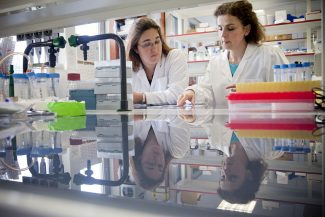 A team from the Institute of Myology research center called “RNA-repair based therapeutic strategies and skeletal muscle pathophysiology, in a study led and conducted by Stéphanie Lorain and Cécile Peccate (UPMC / Inserm / CNRS / Institute of Myology), showed that a pre-treatment made of antisense oligonucleotides improves significantly the benefit of gene therapy for Duchenne Muscular Dystrophy. This “preparation” of dystrophic muscles to the injection of AAV-vectors multiplies by ten the efficacy of the treatment in the muscles of mice models of the disease.
A team from the Institute of Myology research center called “RNA-repair based therapeutic strategies and skeletal muscle pathophysiology, in a study led and conducted by Stéphanie Lorain and Cécile Peccate (UPMC / Inserm / CNRS / Institute of Myology), showed that a pre-treatment made of antisense oligonucleotides improves significantly the benefit of gene therapy for Duchenne Muscular Dystrophy. This “preparation” of dystrophic muscles to the injection of AAV-vectors multiplies by ten the efficacy of the treatment in the muscles of mice models of the disease.
Duchenne Muscular Dystrophy (DMD) is caused by anomalies in the DMD gene coding for sarcolemma dystrophin (membrane around the muscle fiber). Two main therapeutic strategies are being tested in this disease: gene therapy by transfer of cDNA dystrophin (a shortened version of the dystrophin gene) and targeted exon skipping. The latter is currently being tested on patients through direct transfusion of antisense oligonucleotides, which get rid of the exons carrying the mutation responsible for the disease, with contrasting clinical results.
Another exon skipping strategy, developed by the laboratories of the Biotherapies Institute for Rare Diseases, consists in using a gene therapy vector (AAV-U7). Tested on model animals, the efficacy of exon skipping through AAV-U7 is initially very strong but grows significantly weaker after 6 months in the treated muscles. This decrease of efficacy is very much correlated to the loss of therapeutic vectors, likely to be caused by the alterations of dystrophic myofibers’ membranes.
To improve dystrophic muscular fibers’ membranes integrity when injecting the drug carrying vector, the mouse’s muscles have been pre-treated with a unique dose of morpholino antisense oligonucleotides linked with a peptide (PPMO). These synthetic molecules then induce the temporary expression of dystrophin. This pre-treatment allows to maintain effectively the therapeutic vectors, and therefore to improve the therapeutic efficacy with a tenfold increase of the amount of dystrophin after 6 months of observation. The study also shows that the pre-treatment is significantly beneficial for gene therapy through AAV-microdystrophin.
Conducted in collaboration with Matthew Wood’s laboratory in the University of Oxford, this study therefore brings to light the importance of combined approaches to treat patients with DMD, especially since 80% of mutations of the dystrophin gene are eligible for treatments involving the skipping of one or several exons.
This work is online on: http://hmg.oxfordjournals.org/content/early/2016/07/03/hmg.ddw201.abstract

